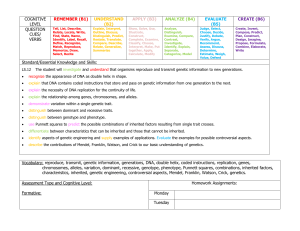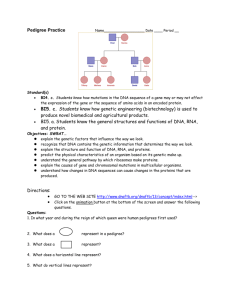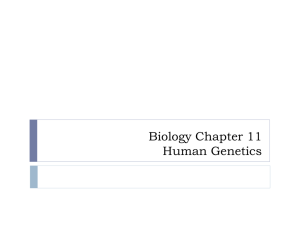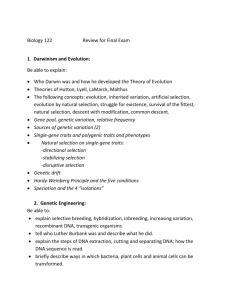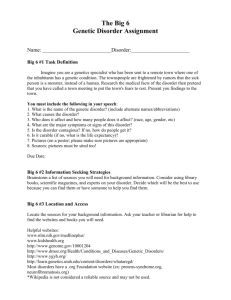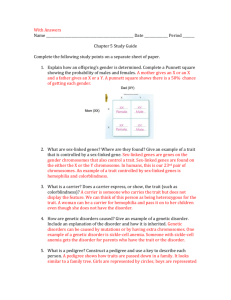Human Genetic Disorders
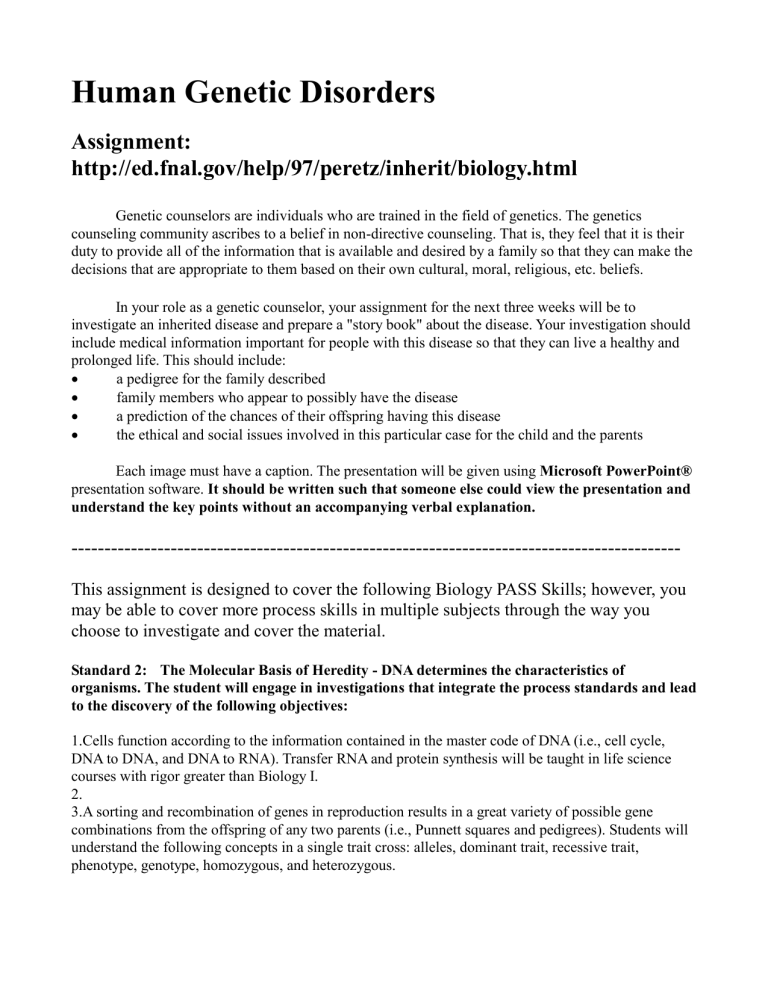
Human Genetic Disorders
Assignment: http://ed.fnal.gov/help/97/peretz/inherit/biology.html
Genetic counselors are individuals who are trained in the field of genetics. The genetics counseling community ascribes to a belief in non-directive counseling. That is, they feel that it is their duty to provide all of the information that is available and desired by a family so that they can make the decisions that are appropriate to them based on their own cultural, moral, religious, etc. beliefs.
In your role as a genetic counselor, your assignment for the next three weeks will be to investigate an inherited disease and prepare a "story book" about the disease. Your investigation should include medical information important for people with this disease so that they can live a healthy and
prolonged life. This should include:
a pedigree for the family described family members who appear to possibly have the disease a prediction of the chances of their offspring having this disease the ethical and social issues involved in this particular case for the child and the parents
Each image must have a caption. The presentation will be given using
Microsoft PowerPoint® presentation software. It should be written such that someone else could view the presentation and understand the key points without an accompanying verbal explanation.
--------------------------------------------------------------------------------------------
This assignment is designed to cover the following Biology PASS Skills; however, you may be able to cover more process skills in multiple subjects through the way you choose to investigate and cover the material.
Standard 2: The Molecular Basis of Heredity - DNA determines the characteristics of organisms. The student will engage in investigations that integrate the process standards and lead to the discovery of the following objectives:
1.Cells function according to the information contained in the master code of DNA (i.e., cell cycle,
DNA to DNA, and DNA to RNA). Transfer RNA and protein synthesis will be taught in life science courses with rigor greater than Biology I.
2.
3.A sorting and recombination of genes in reproduction results in a great variety of possible gene combinations from the offspring of any two parents (i.e., Punnett squares and pedigrees). Students will understand the following concepts in a single trait cross: alleles, dominant trait, recessive trait, phenotype, genotype, homozygous, and heterozygous.
Outcomes:
Students should be able to:
discuss examples of inherited disorders, their symptoms, and their causes.
demonstrate how modern knowledge and techniques have led to understanding the cause of genetic disorders. (If known, show the location of the defective allele).
relate genes and protein synthesis to the expression of phenotypes.
describe techniques that permit diagnosis of a genetic disorder.
demonstrate how increased knowledge and advances in medicine have improved the quality of life for people with the disorder.
use a Punnett square and a pedigree as a tool to provide parents with information about the possibility of having a child with a genetic disorder.
discuss the impact of the disease on the victim, their family, and society.
access, use and manage information from the Internet effectively (using links provided as well as locating other relevant links using search engines).
communicate and collaborate with other people in other locations.
(using e-mail, newsgroup, e-mail, snail mail, and/or telephone).
Presentation Requirements:
The presentation must be at least 10 slides long, not counting resources, title and (student) author information.
Presentation must include a discussion of the following aspects of your inherited disorder:
1symptoms
2causes (etiology)
3diagnosis and treatment
4prognosis
5Punnett square and a pedigree to provide parents with information about the possibility of having a child with a genetic disorder
6impact of the disease on the victim, their family, and society.
7List of resources which you found via the Internet (you should be able
display a copy of your bookmarks and copy these into your presentation).
Presentation Design Tips:
Limit text to about six lines, six words per line. Information on slides is meant to highlight the important points.
Text should not be smaller than 18 points. Use 44 points for titles, 32 points for text, and 28 points for subtext.
Limit yourself to 2-3 easy to read fonts.
Use a dark, gradated background with brightly colored text for an on-screen presentation. Use a clear, light background with dark text for an overhead.
Keep templates simple and free from too many lines, textures, and so on.
Enhance with clip art or graphics.
Avoid having more than three plain text slides in a row. Try to use tables or graphs wherever appropriate.

